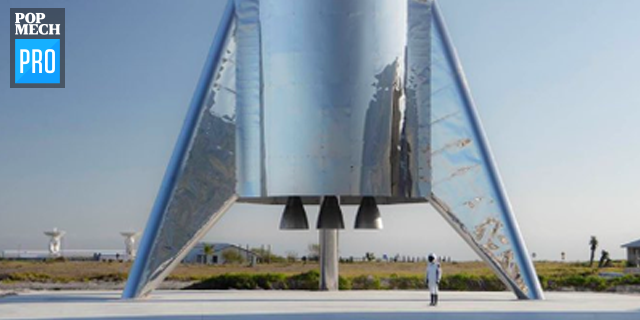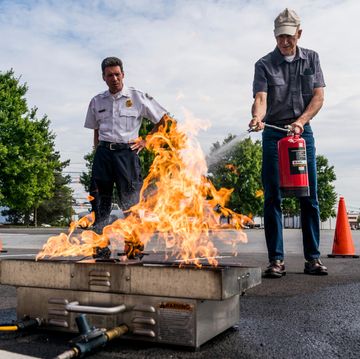So SpaceX is making a huge rocket out of stainless steel. As far as we know, this marks the first time the material has been used in spacecraft construction since some early, ill-fated attempts during the Atlas program in the late 1950s.
We know he is doing this because, after weeks of rumors about a tweak to the design, a few days before Christmas Musk revealed that there would be much more than a tweak. The state-of-the-art carbon fiber forming the body of the Starship rocket (formerly known as the BFR, or Big Falcon Rocket, or Big F-other-word Rocket) and its Super Heavy booster would be replaced by 300-series stainless.
On January 10, Musk tweeted a photograph of a test version of Starship—essentially a prototype that can be used for suborbital VTOL (vertical takeoff and landing) test flights, reaching around 16,400 feet. He is calling these “hops.”
Since the quasi-unveiling, Musk has briefly answered some direct questions from the curious space-watchers of cyberspace via Twitter. But two weeks before the announcement he sat down with Popular Mechanics editor in chief Ryan D’Agostino at SpaceX headquarters in Hawthorne, California, for an exclusive interview in which he discussed, in great detail, the thinking behind the change. He talked about a lot more than that—we’ll be bringing you more soon. For now, here’s what he said about the big change.
Ryan D’Agostino: You’ve been busy redesigning Starship.
Elon Musk: Yes. The design of Starship and the Super Heavy rocket booster I changed to a special alloy of stainless steel. I was contemplating this for a while. And this is somewhat counterintuitive. It took me quite a bit of effort to convince the team to go in this direction.
But now I believe they are convinced—well, they are convinced. We were pursuing an advanced carbon-fiber structure, but it was very slow progress, and the cost per kilogram of $135. And then there’s about a 35 percent scrap rate—you cut the fabric, and some of it you can’t use. It’s impregnated with a high-strength resin, and it’s quite tricky. And there’s 60 to 120 plies.
RD: How does stainless steel compare?
EM: The thing that’s counterintuitive about the stainless steel is, it’s obviously cheap, it’s obviously fast—but it’s not obviously the lightest. But it is actually the lightest. If you look at the properties of a high-quality stainless steel, the thing that isn’t obvious is that at cryogenic temperatures, the strength is boosted by 50 percent.
Most steels, as you get to cryogenic temperatures, they become very brittle. You’ve seen the trick with liquid nitrogen on typical carbon steel: You spray liquid nitrogen, you can hit it with a hammer, it shatters like glass. That’s true of most steels, but not of stainless steel that has a high chrome-nickel content. That actually increases in strength, and ductility is still very high. So you have, like, 12 to 18 percent ductility at, say, minus 330 degrees Fahrenheit. Very ductile, very tough. No fracture issues.
Fracture toughness is a property where if something has a small crack, does the material tend to arrest the crack, or does the crack propagate? So as you go through repeated vibrational multiple stress cycles, how much will a small imperfection in the material propagate?
RD: So some materials can stop their own fissures.
EM: Yeah, like for example ceramic—like a coffee cup—is bad at arresting cracks. Once the crack starts, it’s like glass. Then depending upon what type of metal you have—some metals have better fracture toughness than others—and the fracture toughness can vary with temperature. Toughness is technically the area under the stress-strain curve. So as you put stress on something, how much strain—how much can the object deform? That’s an important benefit.
Stainless steel was something that was used in the early Atlas days. The early Atlas was a steel balloon tank. Now the flaw in the early Atlas program was that the material was so thin that it would collapse under its own weight. It was such a steel balloon that it literally could not even stand up. It would just collapse like a bouncy castle. It couldn’t even take a small payload—there were multiple cases of the early Atlases literally collapsing on the pad and causing a disaster.
There’s a trick here, though, which I think is quite important, when you consider this as a reentry vehicle. See, here’s the other benefit of steel: It has a high melting point. Much higher than aluminum, and although carbon fiber doesn’t melt, the resin gets destroyed at a certain temperature. So typically aluminum or carbon fiber, for a steady-state operating temperature, you’re really limited to about 300 degrees Fahrenheit. It’s not that high. You can take little brief excursions above that, maybe 350. Four hundred, you’re really pushing it. It weakens. And there are some carbon fibers that can take 400 degrees Fahrenheit, but then you have strength knockdowns.
But steel, you can do 1500, 1600 degrees Fahrenheit.
RD: Do you have a whole metallurgy team here?
EM: We do have a great materials group, but initially we will simply use high-quality 301 stainless. There’s an important other thing that makes a big difference. For ascent you want something that’s strong at cryogenic temperatures. For entry, you want something that can withstand high heat. So the mass of the heat shield is driven by the temperature at the interface between the heat shield tiles and the air frame. Whether it’s mechanical or if it’s bonded on—whatever the interface point is—determines the thickness of the heat shield.
On the Dragon, for example, the thickness of the heat shield tiles is actually driven by the heat soak from the heat shield getting to the bond line of the tile onto the shell. So it’s not driven by erosion of the tile. It’s actually driven by conductivity of the tile to the bond line so we don’t lose tiles as it’s descending under a chute. You don’t want to be tossing tiles off, basically.
With steel, now you’ve got something where you can comfortably be at a 1500 F interface temperature instead of, say, a 300 F, so you have five times the temperature capability at interface point. What that means is that for a steel structure, the leeward side of the back shell does not need any heat shielding.
On the windward side, what I want to do is have the first-ever regenerative heat shield. A double-walled stainless shell—like a stainless-steel sandwich, essentially, with two layers. You just need, essentially, two layers that are joined with stringers. You flow either fuel or water in between the sandwich layer, and then you have micro-perforations on the outside—very tiny perforations—and you essentially bleed water, or you could bleed fuel, through the micro-perforations on the outside. You wouldn’t see them unless you got up close. But you use transpiration cooling to cool the windward side of the rocket. So the whole thing will still look fully chrome, like this cocktail shaker in front of us. But one side will be double-walled and that serves a double purpose, which is to stiffen the structure of the vehicle so it does not suffer from the fate of the Atlas. You have a heat shield that serves double duty as structure.
Yeah.
To the best of my knowledge this has never been proposed before.
RD: This is a huge change.
EM: Yes.
RD: Where will the steel come from?
EM: It’s just 301 stainless. Let me put it this way: 304 stainless is what they make pots out of. There’s plenty of it.
RD: What will this do to your schedule?
EM: It will accelerate it.
RD: Because it’s easier to work with?
EM: Yes. Very easy to work with steel. Oh, and I forgot to mention: The carbon fiber is $135 a kilogram, 35 percent scrap, so you’re starting to approach almost $200 a kilogram. The steel is $3 a kilogram.
RD: This is a good idea.
EM: Yeah.
Want more SpaceX news? Get the PM newsletter.















